Pitcairn Islands Travel Guide
This is a Pitcairn Islands Travel Guide from taste2travel.com
Date Visited: June 2024
Introduction
Visiting Pitcairn Island has always been a long-held travel dream!
I used to look at its remote location on a world map and dream that one day I would make the long journey there.

The much-photographed longboat shed at Bounty Bay.
It was only recently that I decided to allocate the time and the (considerable) funds to make my dream come true.
Pitcairn is a truly remote destination which is unlike any of the other place which I have visited.
My journey to Pitcairn was also surprisingly emotional – the realisation of a big travel dream, combined with the wonderful, welcoming, warmth and hospitality for which the Pitcairners are famous, a warmth which embraces you immediately upon arrival and holds you close until you leave.

A view of the rugged south coast of Pitcairn Island.
Upon arrival on the island, everyone gathers to welcome you, and upon departure everyone turns out at Bounty Bay to bid you farewell. A truly special and moving experience.
A visit to one of the remotest, populated, islands on earth is a special travel experience, and offers an insight into a unique way of life which is currently lived by the 40+ souls who call Pitcairn Island home.

A miniature model of the HMS Bounty, inside a bottle, at the Pitcairn Museum.
Most of the population are descendants of the HMS Bounty mutineers, a story which has been immortalised in books, and three Hollywood movies:
- Mutiny on the Bounty (1935), starring Clark Gable and Charles Laughton.
- Mutiny on the Bounty (1962), starring Marlon Brando and Trevor Howard.
- The Bounty (1984), starring Mel Gibson and Anthony Hopkins.

A view of the only church on Pitcairn Island – the Seventh-day Adventist church in Adamstown.
The shortest possible trip to Pitcairn Island requires 8 days and will cost approximately:
- US $6,556
- NZD $10,716
- AUD $9,892
- EUR €6,110
There are 4 major cost components, all of which are fully described in the ‘Costs‘ section below.
The cost of travelling to Pitcairn Island will only ever increase in price. Recently, the cost of a berth on the supply ship – the MV Silver Supporter – has increased by NZ$500!
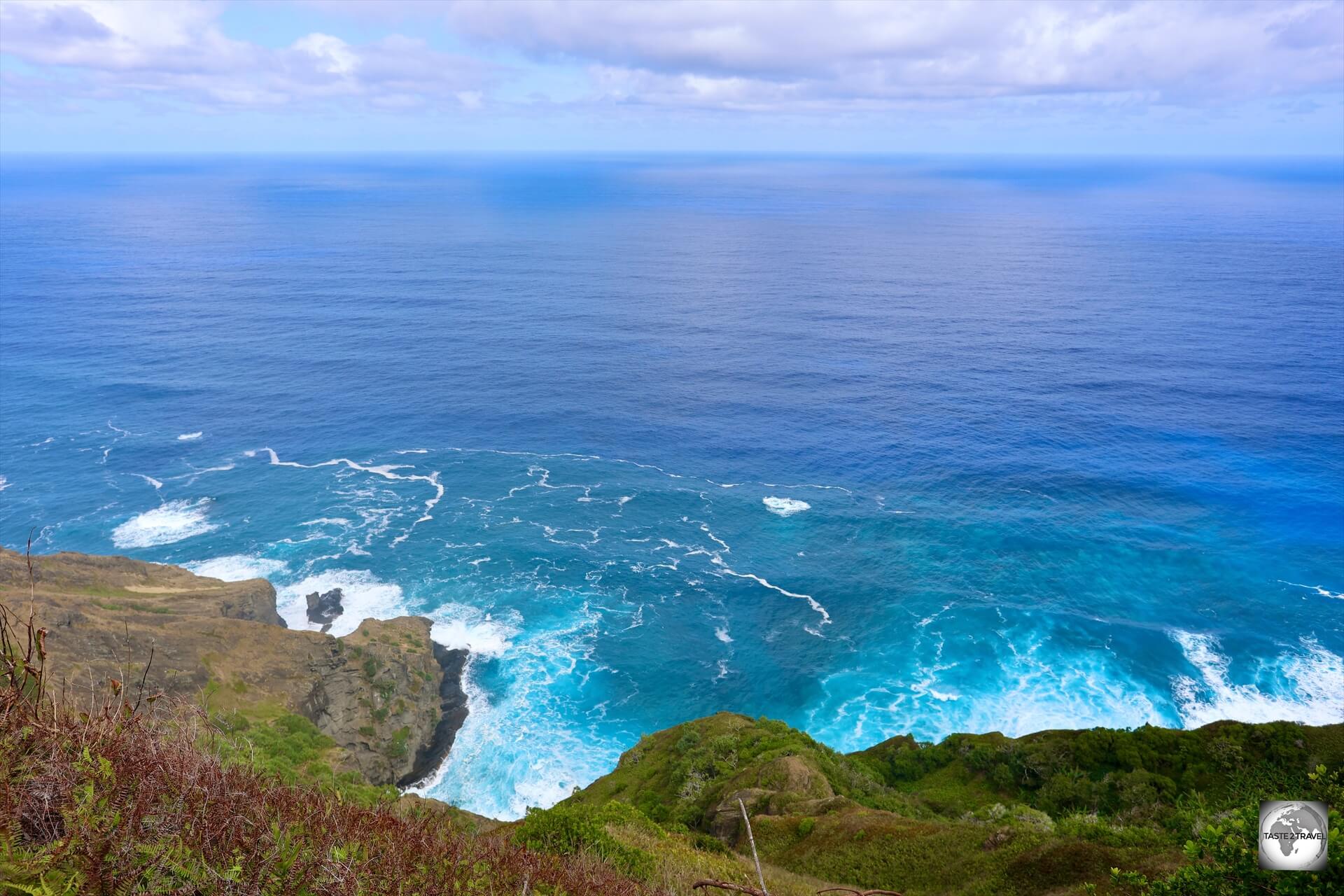
A volcanic island, Pitcairn is surrounded by the deep waters of the Pacific Ocean, with waves pounding against high coastal cliffs.
If you wish to travel to Pitcairn, it’s best to do it sooner rather than later!
I have included detailed information below which will allow you to book your own Pitcairn Island adventure.
Highly recommended!
Breadfruit and the Bounty

Originally from Tahiti, Breadfruit can now be found growing around the world.
The story of breadfruit is integral to the story of Pitcairn Island. Without breadfruit, there would be no story!
The story of British involvement with Breadfruit is fascinating and starts with Captain James Cook, who first discovered it on Tahiti (French Polynesia) where he referred to it as ‘bread growing on a tree’.

A display at the Pitcairn Museum – “Breadfruit – that evil fruit”.
Upon his return to England, Captain Cook reported its existence to the King of England, who decided that a starchy staple that grows on a tree would be ideal to feed a growing slave population in the Caribbean.
The King then commissioned Captain William Bligh to sail the HMS Bounty to Tahiti, to collect, then transplant, 150 young breadfruit trees to the Caribbean.
This journey ended abruptly, off the coast of Tonga, when Fletcher Christian and crew staged their Mutiny on the Bounty!
This was the culminating event of what had been an exceptionally long and arduous sea voyage which was captained by Bligh – someone who apparently had a difficult and abrasive personality.

A plaque, which overlooks Bounty Bay, commemorates the Bounty Mutineers and their Tahitian wives, who first settled on Pitcairn Island in 1790.
The mutineers returned to Tahiti, collected their girlfriends/ wives and set sail for anywhere off the radar. They eventually settled on the very remote Pitcairn Island.
Meanwhile, after rowing 6,500 kilometres west, across the Pacific Ocean, in a small row boat, Captain Bligh reached Batavia (Jakarta) where he then hitched a ride back to England.
Determined as ever, Bligh set sail again for Tahiti, collected a new batch of breadfruit trees, then transported them to the Caribbean, where they were planted on various British-controlled islands.
Today, Breadfruit is a staple of the Caribbean diet and forms an integral part of Jamaican BBQ.
One of the original breadfruit trees, which was planted by Bligh, can be seen today in the Kingstown Botanical Garden, in the capital of Saint Vincent and the Grenadines!
The British eventually transported breadfruit around the world, planting it in those tropical areas where it could grow, providing a valuable food source for young colonies and settlements.
The story of the dispersal of breadfruit from its native Tahiti is a global one, and has been included in many of my Travel Guides. I have included links (above) to those reports which contain mentions of the breadfruit story.
Norfolk Island Travel Guide

To fully understand the story of Pitcairn Island, you also need to understand the story of Norfolk Island, presently an Australian territory which is located a mere 6,271 km (3,300 mi) west of Pitcairn Island, on the other side of the Pacific Ocean.
Norfolk Island is actually home to most of the descendants of the HMS Bounty mutiny.
Following the mutiny, the mutineers settled on Pitcairn Island with their Tahitian wives.
With nothing much to do, by the 1850’s, the swelling population had outgrown its tiny (5 square km) island home.
The Pitcairners appealed to Queen Victoria for a larger piece of real estate, somewhere in the Pacific Ocean.
She responded by allocating the recently abandoned, former penal colony, of Norfolk Island, which lies 1,673 km off the east coast of Australia.

The connection between Norfolk Island and Pitcairn Island is symbolised through the many Norfolk Island pine trees which can be found growing on Pitcairn Island.
On the 3rd of May 1856, a British government-supplied ship relocated 194 Pitcairn Islanders (the entire population) to Norfolk Island, who arrived at their new home on the 8th of June 1856.
The Pitcairn Islanders originally lived in the abandoned convict buildings in Kingston before moving to their own 50-acre land grants, where they built homes and farms.

A plaque written in Norfuk, a creole language from Norfolk Island, based on English and Tahitian, installed on the 200th anniversary of the settlement of Pitcairn Island.
The descendants of the Pitcairn Islanders now make up about a half of the island’s population, and a walk through the rows of headstones in the islands’ one cemetery in Kingston show those who were direct descendants of the Bounty mutineers, with numerous gravestones bearing the surnames of Christian, Quintal, McCoy, Adams and Young.
The Norfolk Island Museum includes relics from the Bounty which were carried to the island when Pitcairn was abandoned in 1856.
Sometime later, a small group of Pitcairners decided to return to Pitcairn Island, where they resettled.
You can read more about Norfolk Island in my Norfolk Island Travel Guide.
Location
Pitcairn Island is a remote island located in the southern Pacific Ocean. It is part of the Pitcairn Islands group, which is a British Overseas Territory.

Hilly Pitcairn Island offers spectacular views in all directions.
The territory consists of Pitcairn Island, Oeno Island, Henderson Island and Ducie Island, with Pitcairn being the only inhabited island.
The island is situated roughly halfway between Peru and New Zealand, and it is one of the most isolated inhabited islands in the world.

Waves, crashing against the south coast of Pitcairn Island.
The capital of Pitcairn Island is Adamstown, which is located roughly 2,170km (1,350 miles) south-east of Tahiti, just over 6,600km (4,100 miles) from Panama, 5,310km (3,300 miles) from Auckland, New Zealand and 7,495 km (4,657 mi) from Sydney, Australia.
The Pitcairn Islands were formed by a centre of upwelling magma called the Pitcairn hotspot.

A former volcano, Pitcairn Island is surrounded by treacherous coastal cliffs such as ‘Down Rope’.
Pitcairn Island is a volcanic remnant primarily formed of tuff, where the north side of the cone has been eroded.
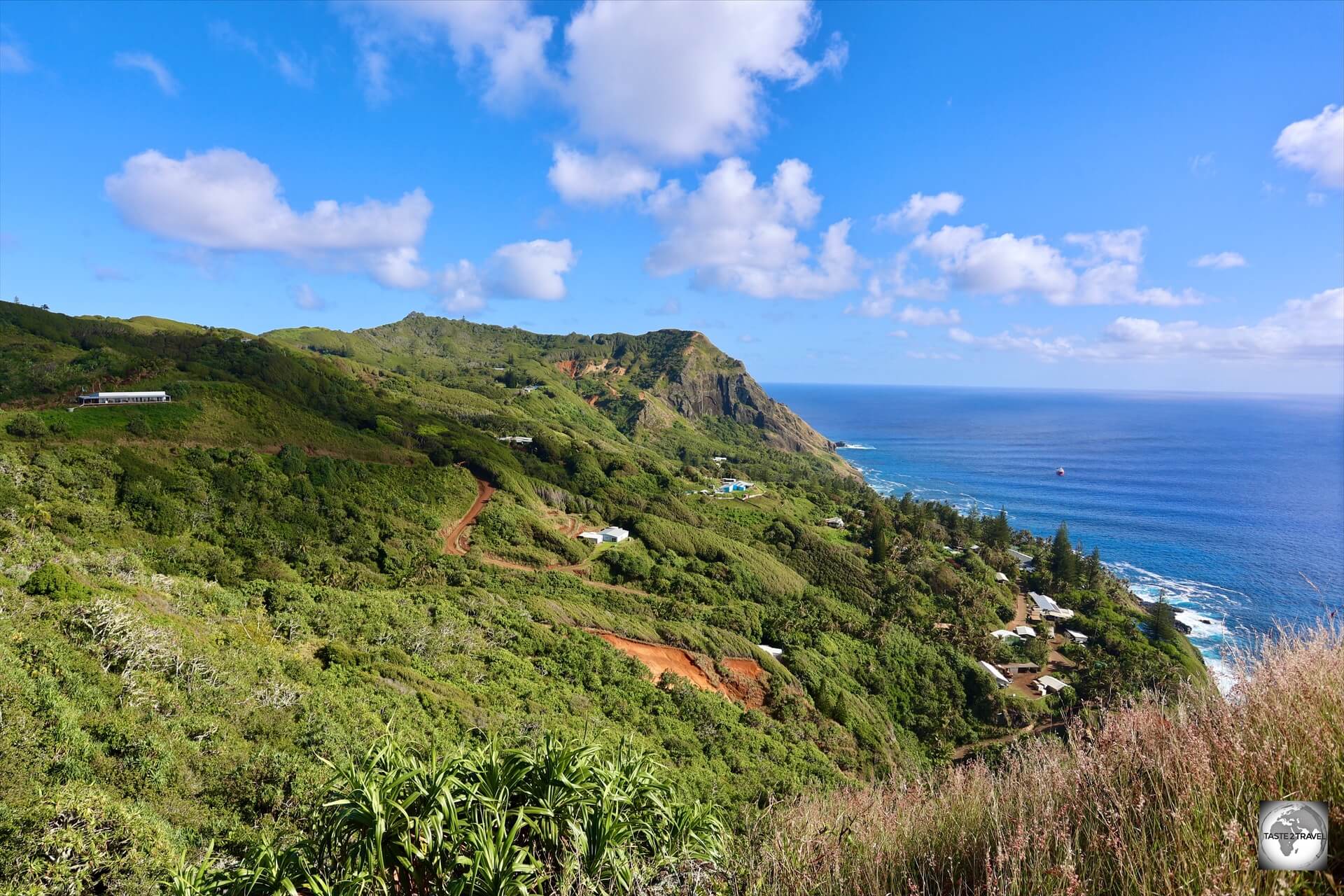
A view of Adamstown, the only settlement on Pitcairn Island.
Adamstown, the main settlement on the island, lies within the volcanic basin.
Water Supply

Water at my homestay was stored in these rainwater tanks which held 70,000 litres of fresh rainwater.
Pitcairn Island has no rivers, springs, reservoirs or any source of fresh water.
The only water supply on the island is collected from the sky. Rainwater is collected in tanks from the rooftops of each home.

Early water tanks on Pitcairn Island were made from wooden palings which made them very leaky.
My homestay featured 4 large tanks which held 70,000 litres of fresh, pure rainwater.
The water was served chilled and also lightly carbonated as Sparkling Pitcairn water. It was just like San Pellegrino!
Chemical-free, it tasted amazing.
People

My hosts, Heather and Kerry Young are both descendants of Bounty Mutineers.
As of April 2021, the total resident population of the Pitcairn Islands was 47.
It is rare for all the residents to be on-island at the same time; it is common for several residents to be off-island for varying lengths of time visiting family or for medical reasons.
A diaspora survey completed by Solomon Leonard Ltd in 2014 for the Pitcairn Island Council and the United Kingdom Government projected that by 2045, if nothing were done, only three people of working age would be left on the island, with the rest being very old.
In addition, the survey revealed that residents who had left the island over the past decades showed little interest in coming back.
Most of the residents of Pitcairn Island are descendants of the mutineers from HMS Bounty and their Tahitian companions.
The small population, and remote location, make Pitcairn Island one of the least populous territories in the world.
Population Decline

An abandoned property on Pitcairn Island.
Pitcairn’s population has significantly decreased since its peak of over 200 in the 1930s, to fewer than fifty permanent residents today.
The island’s community recognise that for the long-term sustainability, re-population is the number one strategic development objective.
The government is committed to attracting migrants, offering free land packages.
Only two children were born on Pitcairn in the 21 years prior to 2012.
However, in this period other children were born to Pitcairn mothers who travelled to New Zealand to receive increased health care safeguards during pregnancy and childbirth.
In 2014, the government’s Pitcairn Islands Economic Report stated that “no one will migrate to Pitcairn Islands for economic reasons as there are limited government jobs, a lack of private sector employment, as well as considerable competition for the tourism dollar.”
The Pitcairners take turns to accommodate those few tourists who occasionally visit the island.
Schooling
There is one school on Pitcairn Island which has been closed for the past two years due to the fact that there are no school-age children living on the island.
Religion

The only church on Pitcairn Island is the Seventh-day Adventist church in Adamstown.
In 1886, the Seventh-day Adventist layman John Tay visited Pitcairn and persuaded most of the islanders to accept his faith.
He returned in 1890 on the missionary schooner Pitcairn with an ordained minister to perform baptisms.

Installed outside the church is this bell from the HMS Dainty, a British Royal Navy destroyer which was decommissioned in 1971.
Since then, the majority of Pitcairn Islanders have been Adventists.

A view of the interior of the Seventh-day Adventist church on Pitcairn Island.
There is just one church on Pitcairn which is the Seventh-day Adventist church in Adamstown.
It’s open for service each Saturday from 11 am to 12 pm and is the main social event on the island each week with locals gathering in the square after the service.
Due to Adventism, the main working day on the island, when most businesses and the one museum is open, is Sunday.
Health
One of the requirements for those wishing to travel to Pitcairn Island is to provide Pitcairn Tourism with a copy of your travel insurance policy which must include medical evacuation coverage.
Pitcairn Island is a long way from the nearest hospital – which is in Papeete, the capital of French Polynesia, 2,320 km to the north-west.
Since there is no airport on Pitcairn, and helicopters cannot reach the island, any medical evacuation involves the slow journey on the supply ship (if it’s not on one of its quarterly trips to New Zealand) to Mangareva.
Once in Mangareva, a special medi-vac flight will need to be organised to fly a patient to Papeete hospital which is a 1,650 km (4-hour) flight.
One medical emergency occurred on the island when a local experienced appendicitis.
At the time, the supply ship was in New Zealand.
The only available option was to use the longboat to travel 540-km in the open ocean to Mangareva.
Unfortunately the patient died before the boat could reach Mangareva.
There is one small clinic on Pitcairn Island and one doctor (currently an Australian) who serves on a yearly contract basis.
Pitcairn Reed Warbler

The Pitcairn reed warbler is the only bird which is endemic to Pitcairn Island.
The Pitcairn reed warbler is the one and only bird which is endemic to Pitcairn Island.

The Pitcairn reed warbler, the only land bird on Pitcairn Island.
Locally known as the “sparrow”, it used to be common throughout the island, where it is the only land bird.

Although listed as ‘endangered’, the Pitcairn reed warbler can be seen throughout the island.
It was formerly classified as a vulnerable species by the IUCN due to its small range, but new research has shown it to be rarer than it was believed.

I found the Pitcairn reed warbler often in banana trees, where it feeds off of any exposed fruit.
Consequently, it was up-listed to endangered status in 2008.
Wildlife
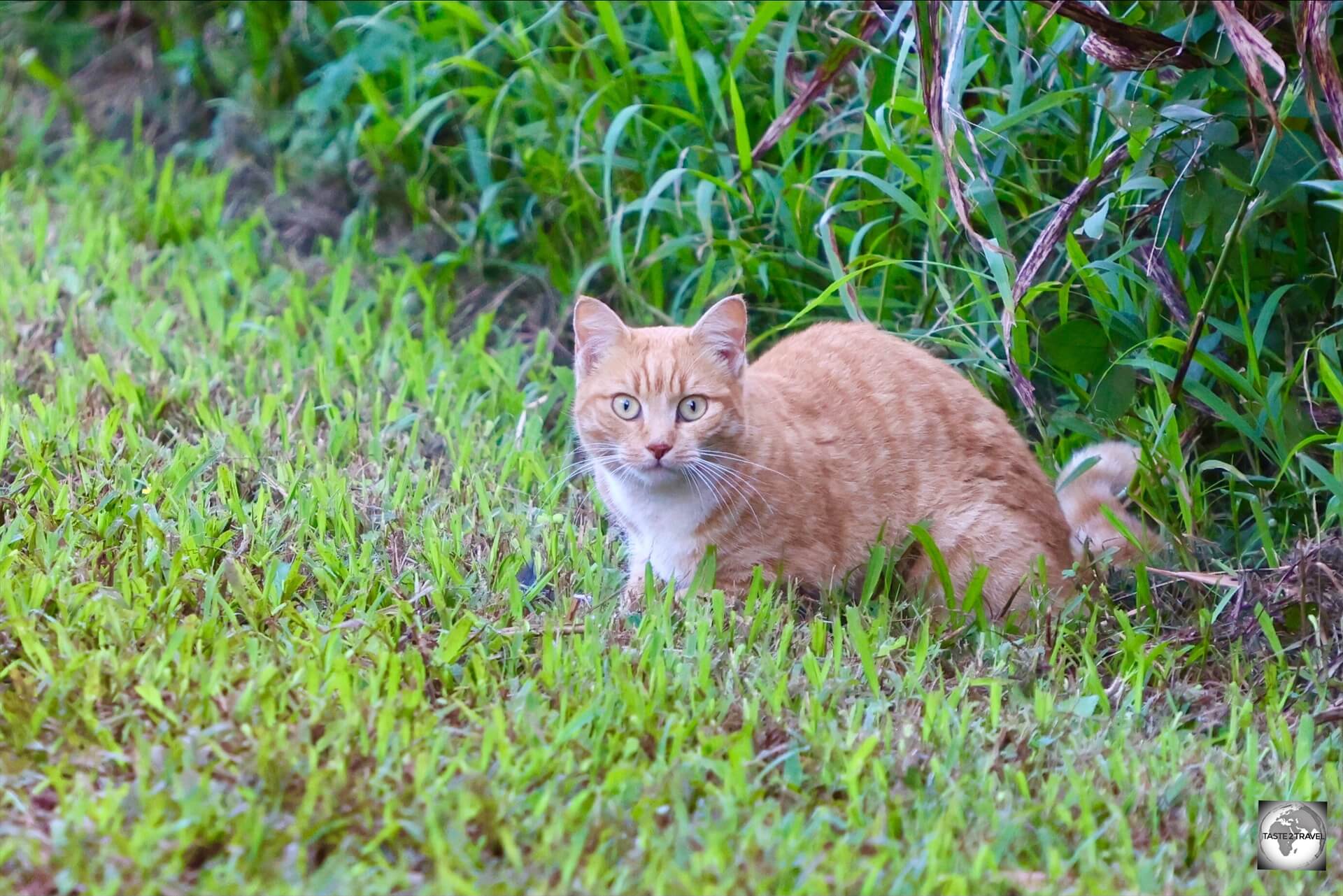
The only wildlife you are likely to see on Pitcairn Island is the odd wild (but very cute) cat!
There is no wildlife on Pitcairn Island, except for a few wild, but very cute, cats who are kept busy keeping the local rat population in check!
Some of these cats have been adopted by the Pitcairners.
Previously, there was a large population of wild goats but these were culled!
Pitcairn Island Tourism
For all things related to tourism on Pitcairn Island, you should refer to the Pitcairn Island Tourist Office website.
Tourism plays a major role on Pitcairn, being the main revenue-maker for the island!
Tourism is the focus for building the economy.
It focuses on small groups coming by charter vessel and staying at “home stays”.
As of 2019, the government has been operating the MV Silver Supporter as the island’s only dedicated passenger/ cargo vessel, providing adventure tourism holidays to Pitcairn on a regular basis.
Tourists stay with local families and experience the island’s culture while contributing to the local economy.
Providing accommodation is a growing source of revenue, and some families have invested in private self-contained units adjacent to their homes for tourists to rent.
Pitcairn Government
For all things government, you should refer to the Pitcairn Government Website.
Shopping
Pitkern Artisan Gallery

My souvenir of Pitcairn – a woven basket which was woven by Daphne Warren, an octogenarian weaver and the last of her kind (glasses case provides scale).
While the journey to one of the remotest places on planet Earth can be long, those wishing to purchase products from Pitcairn Island can do so without leaving home, thanks to the online Pitkern Artisan Gallery.
While orders can be placed online in a matter of minutes, it can take several months to receive your shipment.
All orders are first dispatched from Pitcairn Island to New Zealand on the quarterly supply ship.
Once in New Zealand, shipments enter into the international mail system and will then be forwarded onto customers around the world.
Pitcairn Honey

Pitcairn honey on toast for breakfast at my homestay.
One especially popular item from this remote outpost is Pitcairn Honey – which is often sold out due to high demand.
A jar of Pitcairn honey (as pictured above) currently sells for US$35!
Pitcairn bees, which have existed in blissful isolation for centuries, are known for their good health and purity. They produce a honey of intense, unique, subtle flavour.

Beehives on Pitcairn Island, home to the purest honey in the world!
I was fortunate to be able to enjoy Pitcairn honey on my morning toast while staying with Heather and Kerry Young.
You can purchase Pitcairn honey online through the PIPCO website although all deliveries from the island are dispatched on the quarterly supply ship to New Zealand where they are then posted to customers around the world.
Other honey-related products (e.g. Honey soap) are available for purchase from the Pitkern Artisan Gallery.
General Store

The General Store in Adamstown is the only mini-market on the island.
Located in the Pamai Centre, the General Store is the only mini-market on the island.
Built in 2020, with funds from the European Union, the Pamai Centre is the only commercial centre on the island, housing the General Store, Post Office and Treasury Office.
The General Store sells a limited range of grocery and household items which arrive on the island every 3-months on the supply ship from New Zealand.
The store is closed more than its open! During my visit, it was open only on Sunday morning for about 2 hours!
Flag

The Flag of Pitcairn Island.
The Pitcairn flag features a Blue Ensign with the Pitcairn coat of arms on the fly side.
The design was suggested by the Island Council in December 1980 and approved on 2 April 1984.
It was first flown in May 1984, during a visit by the then-governor Sir Richard Stratton.

The flag of Pitcairn Islands, flying over the main square in Adamstown.
The Pitcairn coat of arms features several symbols relevant to the ancestral history and culture of the Pitcairn Islanders, most of whom are descended from the sailors who mutinied on the HMS Bounty in 1789.
The blue, yellow and green of the shield symbolise the island of Pitcairn rising from the Pacific Ocean, while the anchor and Bible are symbols of the Bounty.

The crest of Pitcairn Islands.
The shield is surrounded by a green and gold wreath, and crested by a helmet bearing a wheelbarrow and a slip of miro, a local tree, which represents the role agriculture played in helping the mutineers survive on the island.
Time Zones

Pitcairn Island’s time zone is GMT-8.
Pitcairn Island is located in the GMT -8 time zone, along with most of the west coast of Canada and the United States.
- There is a one-hour time difference between Papeete (GMT -10) and Mangareva (GMT -9).
- There is a one-hour time difference between Mangareva (GMT -9) and Pitcairn Island (GMT -8).
WiFi
Despite its remote location, Pitcairn Island enjoys incredibly fast WiFi thanks to Starlink – a satellite internet system that provides high-speed broadband access to anywhere on the planet.
It’s operated by SpaceX and run by Elon Musk.
Following a recent upgrade, the MV Silver Supporter now offers Starlink WiFi!
Communications

ABC (Australia) is the only TV channel which is received by the satellite on Pitcairn Island.
The text for this section has been kindly provided by Mike Collis, who has recently settled on Pitcairn Island, from the United States, where he previously worked for 20 years as a broadcast engineer for KCBS/KCAL in Los Angeles.
- Country code for Pitcairn is 64 (the same as New Zealand)
- City code for Pitcairn is 9 (the same as Auckland)
Philately

The stamps of Pitcairn Island make for inexpensive souvenirs.
Stamps from remote islands are always popular with philatelists around the world, and with Pitcairn Island being one of the remotest islands, its stamps are especially popular.
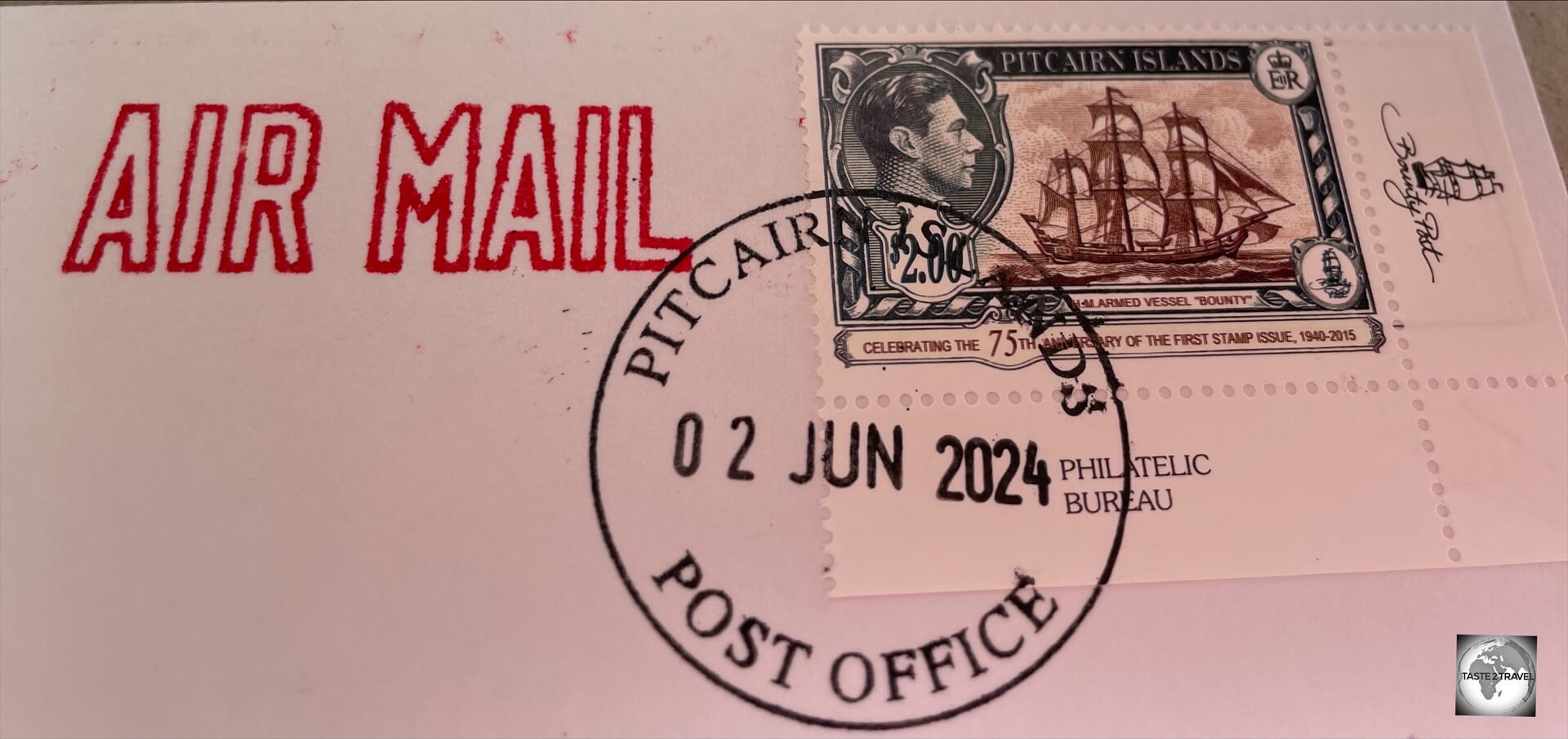
The sale of stamps is an important source of revenue for tiny Pitcairn Island.
Pitcairn Island stamps used to be sold online by the Pitcairn Islands Philatelic Bureau but, since 2021, are sold online through Tower Mint in the UK.

The Pitcairn Island post office is located in the one small commercial centre in Adamstown.
If you are ordering stamps online, you will receive your stamps much faster from Tower Mint, who dispatch from the UK, rather than from Pitcairn Island post office, where all items are dispatched on the quarterly supply ship to New Zealand and then posted from there.

I purchased this sheet of Pitcairn stamps for NZ$16! It will one day be framed and displayed on a wall. An ideal souvenir of Pitcairn Island!
On the island, stamps can be purchased at the Pitcairn Islands General Post Office in Adamstown.
The post office is located in the Pamai Centre, alongside the General Store and the Treasury Office.
Like everything else on the island, the post office is closed more than it’s open!
The best time to visit is Sunday morning when the post office is open from 8 am to 10 am.

Introducing Charlene, the friendly and helpful postmaster on Pitcairn Island.
The main benefit of purchasing stamps from the post office is that they will be postmarked with the (rather plain) Pitcairn Islands postmark.

The (somewhat plain) Pitcairn Islands postmark.
It would be nice to see some artwork on the postmark – maybe an image of the HMS Bounty.

A display of stamps for sale at the Pitcairn post office.
The post office displays the latest postage stamps and has all matter or philatelic items available for purchase.
Postcards

The post office sells a range of post cards – excellent gifts for friends and family.
The only place to purchase postcards is at the post office.
I don’t normally send post cards but Pitcairn is no ordinary destination and many requests for postcards were received from family and friends!
Whenever will people have the opportunity to receive a postcard from such a remote corner of the world?
All postal items from Pitcairn Island are sent to New Zealand on the quarterly supply ship from where they enter the international postal system.
Currency
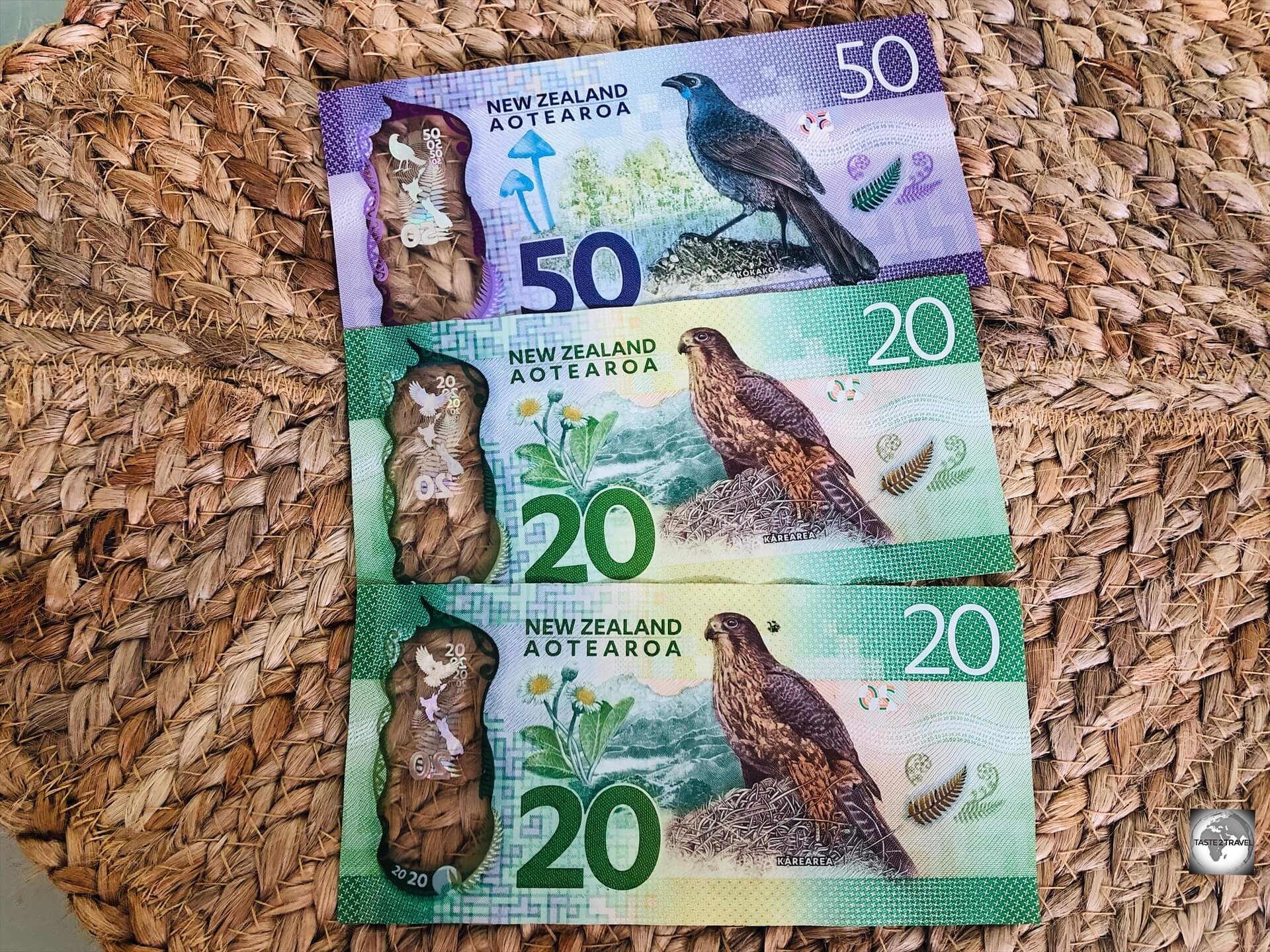
The New Zealand dollar (NZD) is the official currency of Pitcairn Island.
The official currency of Pitcairn Islands is the New Zealand Dollar (NZD).
As a British Overseas Territory, Pitcairn Islands do not have their own currency, so they use the New Zealand Dollar as their official currency.
The New Zealand Dollar is also used in other Pacific Island nations, such as Niue, Tokelau, and the Cook Islands, which are also associated with New Zealand.

The official currency of Pitcairn Island is the New Zealand Dollar (NZD).
While the New Zealand dollar is the official currency, many prices are quoted in United States dollars (USD) which are also widely accepted on the island.
Banking Services
There are no banks on Pitcairn Island, however, cash advances, on credit card, are available at the Treasury Office, which is located in the Pamai Centre, between the post office and the general store.
ATMs
There are no ATMs on Pitcairn Island.
Credit Cards
Credit Cards are only accepted at the Treasury Office for the purpose of cash advances.
Costs
A trip to Pitcairn isn’t cheap. The high cost of travel ensures that the island only receives the most dedicated and determined of visitors.
There are four main cost components involved with a trip to Pitcairn. They are:
- A return flight to Papeete, French Polynesia from wherever you are located in the world (e.g. US$1,200 from San Francisco).
- A return flight from Papeete to Mangareva (US$886).
- A return trip on the MV Silver Supporter supply ship (NZ$6000 – approximately US$3,670).
- Four days accommodation on Pitcairn Island (US$800).
Therefore, a one-week trip to Pitcairn Island will cost approximately:
- US $6,556
- NZD $10,716
- AUD $9,892
- EUR €6,110
This does not include any accommodation costs in French Polynesia.
Cost item 1

Papeete, the capital of Tahiti, is the international gateway for trips to Pitcairn Island.
Flights to Papeete (pronounced as pah-pay-eh-tay) are limited and, hence, expensive!
The following airlines provide international flights to/ from Papeete:
- Air France – flies to/ from Los Angeles, Paris–Charles de Gaulle
- Air New Zealand – flies to/ from Auckland
- Air Rarotonga – flies to/ from Rarotonga
- Air Tahiti Nui – flies to/ from Auckland, Los Angeles, Paris–Charles de Gaulle, Seattle/Tacoma, Tokyo–Narita
- Aircalin – flies to/ from Nadi, Nouméa
- French Bee – flies to/ from Paris–Orly, San Francisco
- Hawaiian Airlines – flies to/ from Honolulu
- United Airlines – flies to/ from San Francisco
A typical return airfare from San Francisco, with United Airlines, costs around US$1,200 while a return airfare from Auckland, with Air New Zealand, typically costs around US$1,100.
Cost item 2

My Air Tahiti flight at Mangareva.
The only airline which flies between Papeete and Mangareva (the main island in the Gambier Islands group) is Air Tahiti who fly the 1,640 km trip twice a week – every Tuesday and Saturday.
The MV Silver Supporter times its schedule to coincide with the Tuesday flight. You fly into Mangareva on a Tuesday and fly out again the following Tuesday.
The cost for a return flight to Mangareva is typically US$886.
With such an expensive airfare, to what is a stunningly beautiful and truly remote part of the world, it would be a shame to treat the Gambier Islands as simply a transit point.
At the end of my trip to Pitcairn, I stayed longer in Mangareva, departing on the Saturday flight, which gave me 4 days to explore the Gambier Islands.
Highly recommended!
Mangareva Travel Guide

The lagoon at Mangareva, the main island of the Gambier Islands, one of five archipelagoes in French Polynesia.
Mangareva is the main island of the tiny Gambier Islands group, the remotest archipelago in French Polynesia.
It’s a long way to the Gambier Islands from Papeete, (a flight of 4-hours and a distance of 1,640 km) and it’s not cheap to reach, with a typical return airfare costing US$886.
I decided it was worth spending some time exploring the Gambier Islands before flying back to Papeete.
When would one ever visit this part of the world again?
For a unique, authentic experience far away from anywhere, I would recommend spending some days on the very relaxed and sleepy Mangareva.
I have included information for the Gambier Islands in my French Polynesia Travel Guide.
Cost item 3
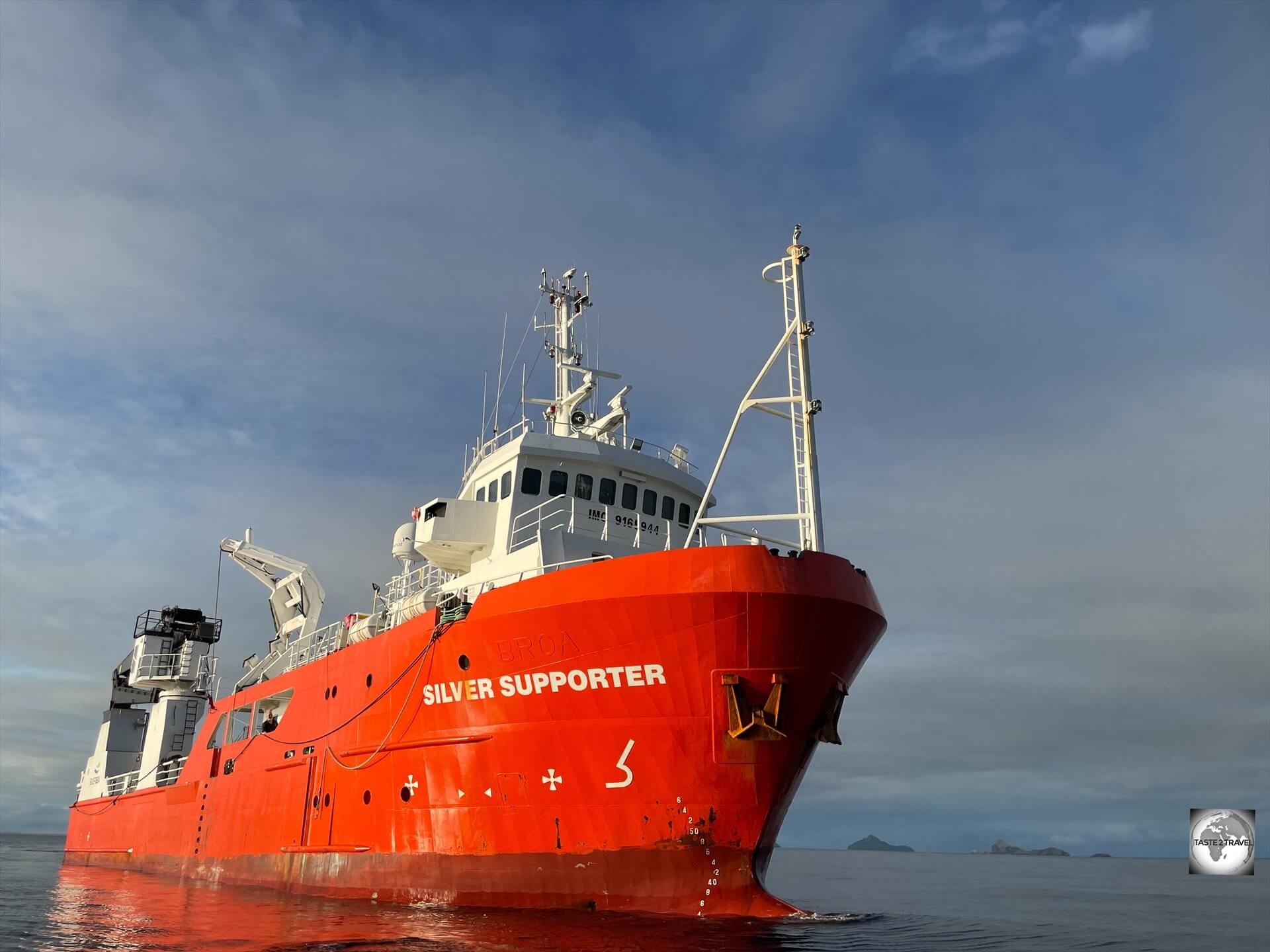
The MV Silver Supporter is the dedicated supply and passenger ship for Pitcairn Islands.
The cost of a return passage on the Pitcairn Island supply ship – the MV Silver Supporter – is NZ$6000!
The cost has recently increased from NZ$5,500 which is a decision made in London by the UK government and not a decision made by anyone on Pitcairn Island.
A berth on the MV Silver Supporter can be booked on the Pitcairn Islands Tourism website.
Locals travel on the boat for a flat fee of NZ$500 – even if travelling all the way to Tauranga, New Zealand!
The boat can carry a maximum of 12 passengers in 6 twin-share cabins.
Please refer to the ‘Getting There‘ section below for full details on how to book.
Cost item 4

‘Big flower’ – the stylish and modern home of Heather and Kerry Young, my homestay on Pitcairn Island.
With a complete lack of hotels, accommodation on Pitcairn Island is in the form of homestays, with a typical homestay costing US$200 per night.
The cost includes all meals and return transfers from Bounty Bay on a 4WD quad bike!
A four day stay on the island will be billed at 4 x US$200 = US$800.
Please refer to the ‘Accommodation‘ section below for full details on how to book.
Sightseeing

A map in Adamstown indicates places, sights and walking trails on Pitcairn Island.
Pitcairn Island Virtual Tour
Interesting in viewing some of the sights of Pitcairn Island from the comfort of your armchair?
You can do so through the virtual tour page on the Pitcairn Islands Tourism Website.
Videos:
Following are three videos taken from the back of the quad bike while exploring Pitcairn Island with my informative host, Kerry Young.
Bounty Bay

A view of Bounty Bay from Adamstown.
Named after the HMS Bounty, Bounty Bay is the one harbour which connects Pitcairn Island to the outside world.
Due to the bay’s shallow depth (15 metres), ships must moor offshore.
With no airport on the island, the bay serves a crucial role as a point of entry and exit to the island for people and goods.
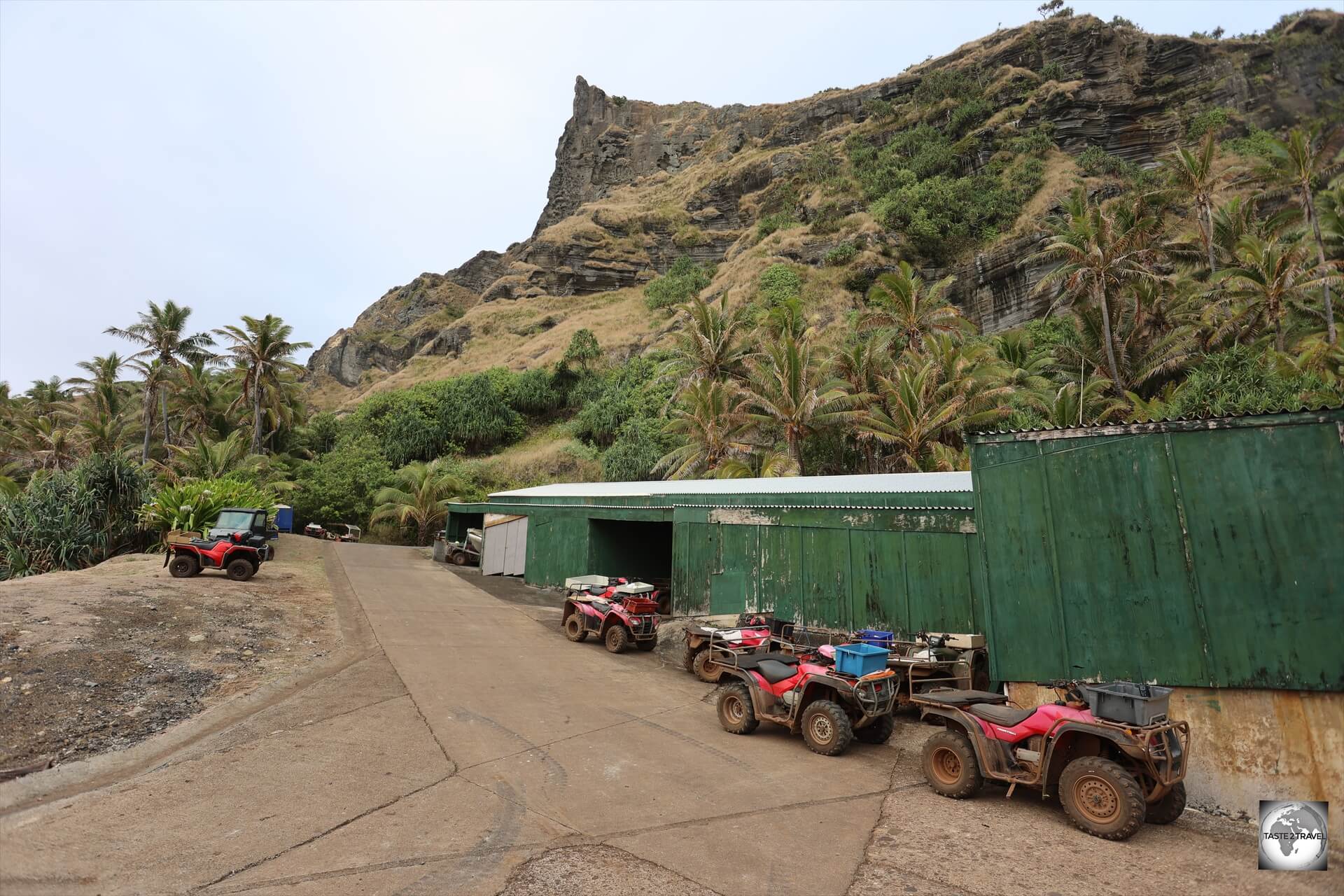
Quad bikes, the most common vehicle on Pitcairn Island, parked at Bounty Bay.
The mutineers sailed the Bounty to Pitcairn Island and destroyed it by fire in the bay, thereby committing themselves to their remote island home and ensuring that no passing boat would locate the Bounty and the hiding mutineers.
All travellers to Pitcairn are brought by longboat into Bounty Bay.

Unloading the quarterly supply shipment at Bounty Bay.
Pitcairn currently uses one aluminum longboat, built to the islander’s specifications, and named “Moss”.
The boat is around 13 metres in length and can carry up to 10 tonnes of cargo at any one time.
All goods which arrive on the quarterly supply ship – the MV Silver Supporter, are shipped to shore using the “Moss”.
This single longboat is of vital importance to the island.

A view of the longboat shed at Bounty Bay from Adamstown.
Bounty Bay is connected to Adamstown by a concrete road which winds its way up the ‘Hill of Difficulty‘.
Video:
Travelling up the ‘Hill of Difficulty’, from Bounty Bay, after my arrival on Pitcairn Island.
The quad bike, which is loaded with myself, and my luggage, is driven by Kerry Young, my host.
Adamstown

A road sign in Adamstown, the capital of Pitcairn Island.
Pitcairn Museum

The one museum on Pitcairn Island is open every Sunday morning.
Established in 2005, the Pitcairn Island Museum includes archaeological material from the earliest Polynesian settlers, as well as artefacts from HMS Bounty.

Views of the informative displays at the Pitcairn Museum.
Originally, volcanic Pitcairn Island was used as a stone quarry by Polynesian seafarers who used the volcanic stones to build adzes and other weapons and tools.
The museum provides interesting insights into early Polynesian settlement of the island.

A view of the Pitcairn Museum.
Most of the displays are dedicated to the HMS Bounty and include a cannon which was restored by the Queensland Museum, before being returned to Pitcairn Island.

A display at the Pitcairn Museum.
The museum is open every Sunday morning!
Bounty Anchor

The anchor from the HMS Bounty, on display in the main square of Adamstown.
The anchor from the HMS Bounty is on display in the main square in Adamstown.
Public Hall

The former Public Hall on Pitcairn Island.
The Bounty anchor is installed in front of the former Public Hall which has now been abandoned due to structural issues.
A new hall is currently being constructed across the street.
Bounty Canon

A cannon from the HMS Bounty, on display in Adamstown.
A rust-covered cannon from HMS Bounty is on display on the main street in Adamstown.
This cannon was retrieved from the watery depths of Bounty Bay.
John Adam’s Grave
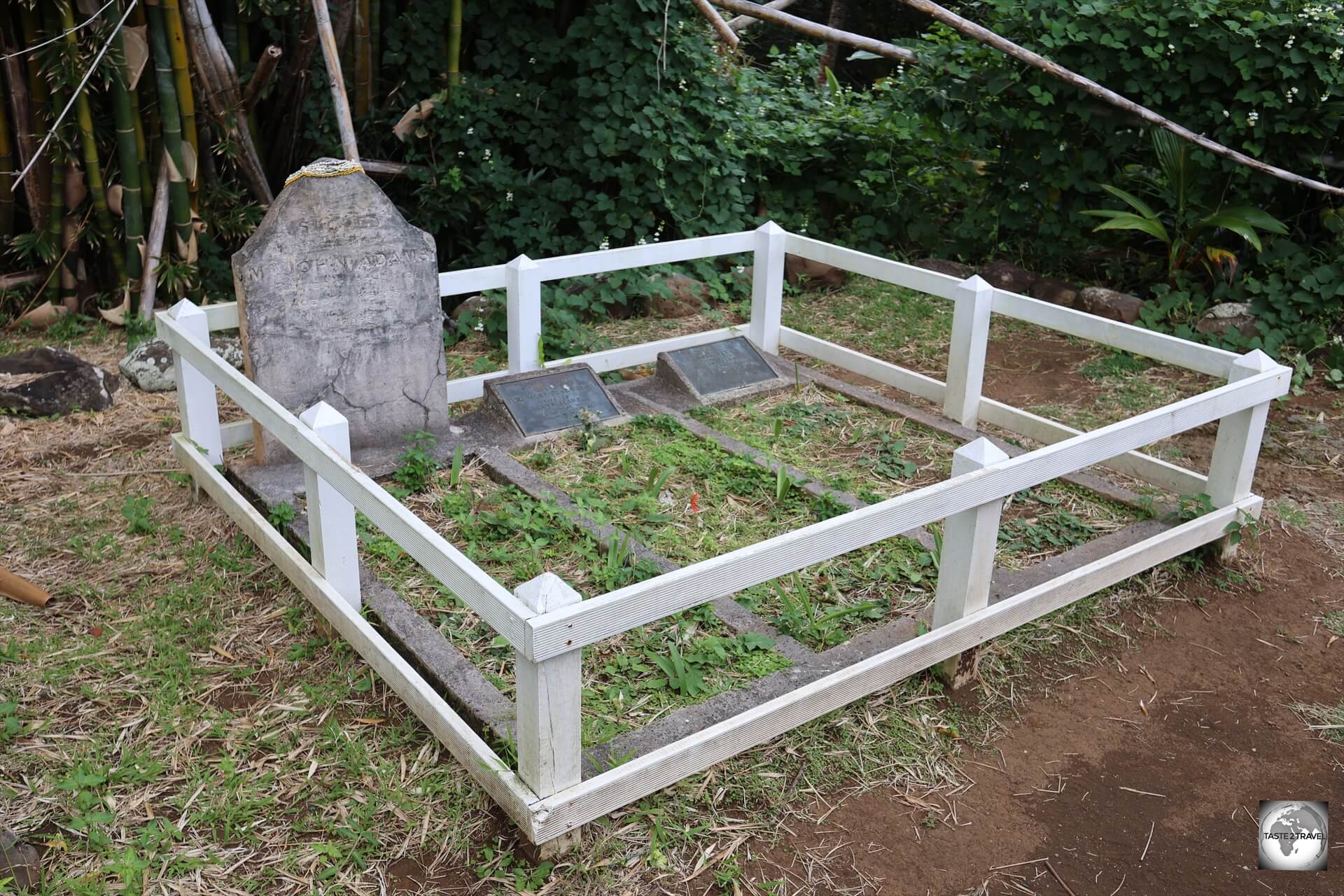
A view of John Adam’s grave in Adamstown.
Adamstown is named after John Adams, who was the last survivor of the Bounty mutineers who settled on Pitcairn Island in January 1790, the year after the mutiny.

Adamstown is named after John Adams, who was the last surviving Bounty mutineer on Pitcairn Island.
His grave is located in Adamstown, where he is buried alongside his Tahitian wife and daughter.
Adams’ grave on Pitcairn is the only known grave site of a Bounty mutineer.
Pitcairn Cemetery

A gravestone in Pitcairn cemetery.
While John Adams and his wife and daughter are buried in their own private plot, the island has one cemetery in Adamstown, which is the final resting place for anyone who has passed away on the island.
As can be expected, the grave stones reflect the island’s Bounty heritage with most markers bearing the surnames of Christian, Young, Brown etc.
Wooden Longboat

The last wooden longboat built on Pitcairn Island is on display in Adamstown.
Everything not produced on Pitcairn arrives by sea and is shipped ashore using longboats.
In 1819 Captain Henry King donated a boat to the Island and in 1880 Queen Victoria gifted two whaleboats.
The longboats of Pitcairn are reputed to be modelled on this whaleboat pattern. Over time the boats have been modified and enlarged but essentially retain the same look.
The Pitcairners built their own boats, and up until the 1980s, the boats were made of wood.
The last wooden boat was made in 1983 and retired in 1995 when it was replaced with a New Zealand made aluminum boat.
The last wooden longboat is on display in Adamstown opposite the General Store.
Pitcairn Prison

A view of the Pitcairn Prison which was built in 2004 to house six inmates convicted of sex offenses.
In the early 2000’s, tiny Pitcairn Island made worldwide news due to a sex scandal which dated back generations!
A British policewoman, Gail Cox from Kent, was stationed on Pitcairn Island in 1999 for a short-duty secondment, but during her stay she discovered evidence of historic child sex offenses.
Her report led to historic sex charges, one dating back to 1972, against a number of Pitcairn Island men.
On 24 October 2004, the Pitcairn Supreme Court convicted six of the seven accused on 35 of the 55 charges.

Views of the former prison cells at Pitcairn prison.
Those who were convicted represented most of the island’s able-bodied men.
Following the convictions, a prison needed to be built on the island to house the six inmates.

A plaque installed at the Pitcairn cemetery offers and apology for the sexual offenses of the past.
However, the only people who could construct the prison were those who had been convicted.
After they had built the prison complex, the six convicted inmates then served their time!

A view of one of the empty prison cells which have been used to accommodate tourists in the past.
However, the men were needed on a regular basis to perform their usual, crucial, tasks on the island and hence were frequently released.
Today, the prison gate is always open and the empty cells are unlocked.
The very comfortable former cells have served multiple purposes such as tourist accommodation or even a gym.
Saint Paul’s Pool

St. Paul’s Pool, a natural lava rock pool at the westernmost point of Pitcairn Island.
One of the most dramatic and spectacular sights on Pitcairn Island is Saint Paul’s Pool, a natural lava rock pool at the westernmost point of the island.

A wave inundates St. Paul’s Pool, a natural lava swimming pool.
While the turquoise blue waters of the pool look inviting, the pool can be very dangerous during high sea swells, which are very common on the totally exposed Pitcairn Island!

St. Paul’s Pool is not a safe place to swim during large swells.
During such swells, large waves inundate the normally calm waters of the pool, creating strong currents that can wash you out to sea.
Pawala Valley Ridge

A distance indicator at the highest point on the island at the Pawala Valley Ridge.
Pawala Valley Ridge, is the highest point of the Pitcairn Islands, with an elevation of 347 metres (1,138 ft).
A lookout, marked by a distance indicator, provides panoramic views in all directions.

Views over Pitcairn Island and Adamstown from the Pawala Valley Ridge.
Christian’s Cave

A sign points the way to Christian’s cave on Pitcairn Island.
One of the many hikes on Pitcairn Island is to Christian’s cave.
However, hikers should be warned that the final part of the trek is a scramble up a slippery, 45°, slope that is without any sort of track and without much in the way of traction. It’s a slope of slippery gravel and grass!

The steep, slippery slope which you must climb to reach Christian’s cave.
The cave hike is off-limits to visiting cruise ship passengers and it is advised that you only climb the slope with an experienced local hiker such as Kerry Young, who has mapped hiking trails throughout the island.
You should also only attempt this climb if you are wearing proper hiking boots with very good grip.

A view of the north coast of Pitcairn Island from near Christian’s cave.
Accommodation

A view of my beautiful homestay on Pitcairn Island – “Big Flower” – the home of Heather and Kerry Young.
With a total lack of hotels on Pitcairn Islands, all visitors are accommodated in the homes of local families.

My cosy room at ‘Big Flower’, the home of Heather and Kerry Young.
Accommodation arrangements are to be made, and paid for, in advance through the Pitcairn Island Tourist Office.
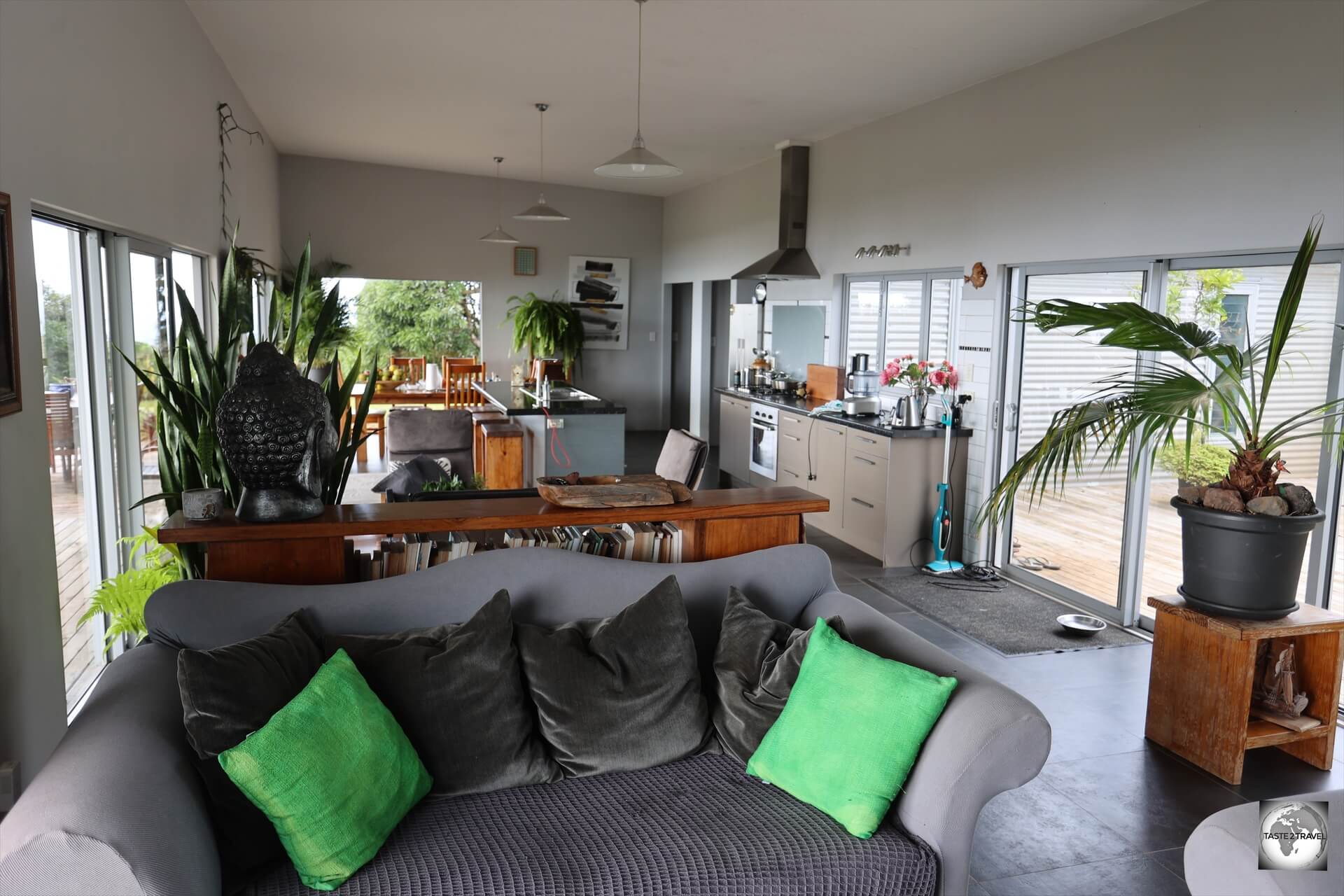
The modern and stylish living room at ‘Big Flower’.
Accommodation options can be viewed on the Where-to-Stay page of the Pitcairn Island Tourist Office website. There are currently 12 homestays listed on the website.

The inviting outdoor area at my homestay.
With no builders on the island, locals are responsible for building their own homes, using materials which are shipped in from New Zealand on the quarterly supply ship.
It took Heather and Kerry two years to build their beautiful home which is perched on a high ledge, above Adamstown.

The view of Pitcairn Island, with Adamstown below, the MV Silver Supporter, and the endless blue of the Pacific Ocean, from my homestay.
Most accommodation packages cost around US$200 per person, per day, which will be billed at US$800 for a 4-day stay.

Heather and Kerry have also built ‘Little Flower’ a self-contained cottage, on an adjacent block of land.
Eating Out

All of my meals on Pitcairn, such as this delicious roast lamb dinner, were prepared by Heather Young, who is an amazing cook.
There is no such thing as ‘Eating Out’ on Pitcairn Island – you always ‘Eat In’.
With a total lack of dining options on Pitcairn Island, home cooked meals for visitors are included in their accommodation package.

The garden at Heather and Kerry’s homestay. The potatoes and onions were drying out in the sun as they had just arrived on the supply ship from New Zealand.
Due to its remote location, and the unreliable nature of supply ships, locals tend to be self-sufficient when it comes to food production, with the fertile volcanic soil on the island put to good use.
Throughout the island, locals grow a wide range of fruit and vegetables.

Delicious apple pies which Heather prepared for dinner one evening.
There are pop-up gardens everywhere, and everyone has their own backyard garden.
In the garden of my homestay, there was a productive vegetable and herb garden, orange, lemon and avocado trees.
As you walk around the island, you pass many fruit trees, where the fruit can be freely picked.

A fresh batch of amazingly delicious cookies which were baked by Heather Young.
Despite being an island surrounded by an abundance of fish and seafood most locals buy imported New Zealand meat at the General store.
One evening, Heather prepared a delicious roast lamb dinner. Divine!
Visa Requirements
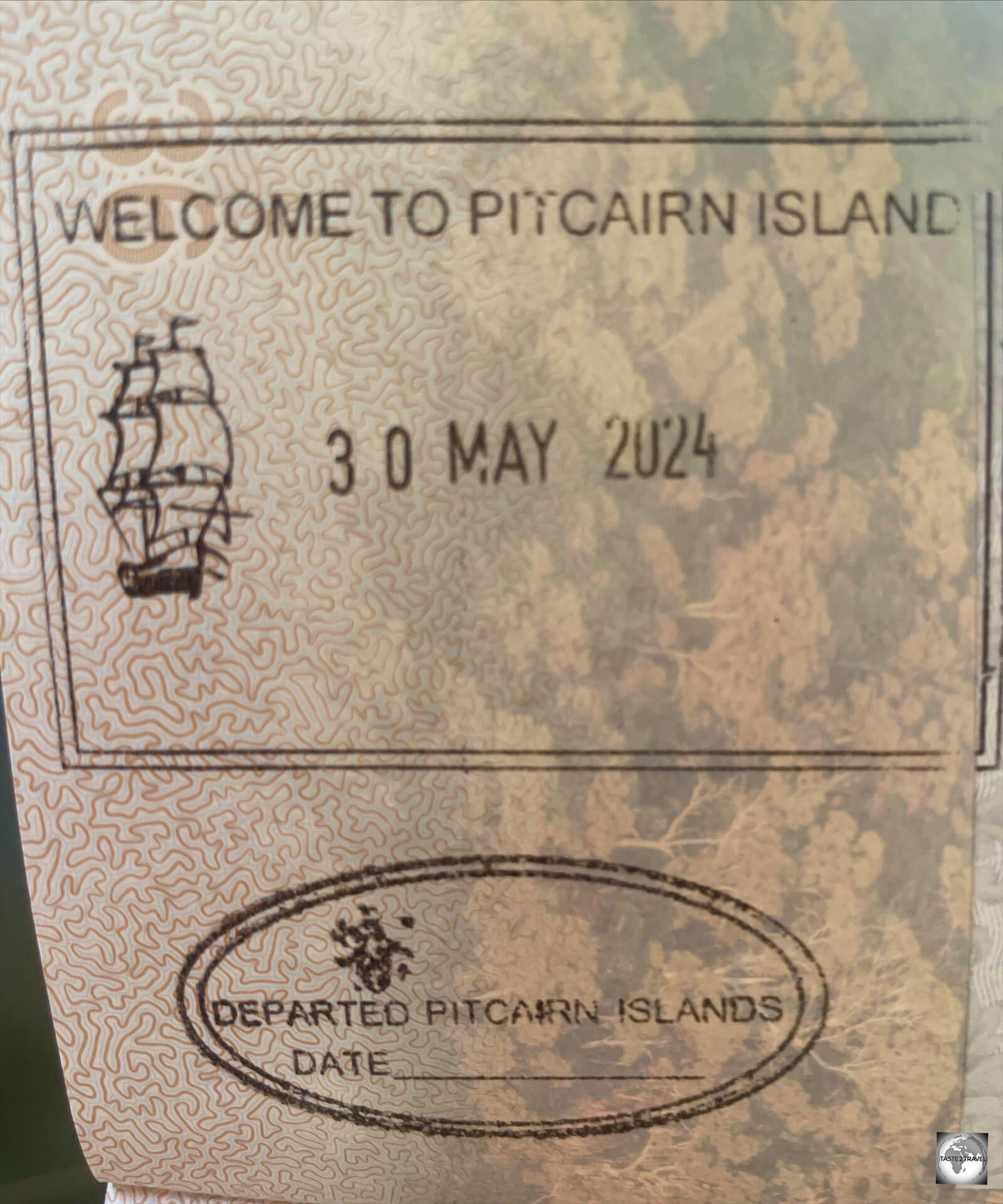
One of the world’s rarest passport stamps.
The Pitcairn Island passport stamp is one of the rarest passport stamps in the world.
Pitcairn Island is welcoming to all!
You can visit for up to 14 days without a visa if you plan to arrive and depart on the same ship.

The Pitcairn Island Landing Card must be completed by all arriving passengers.
You must fill in a landing card on arrival.
Passports will be stamped when you come ashore at Bounty Bay.
The immigration officer will stamp both your entry and exit stamp at the same time. You simply date your exit stamp when you depart from the island.
To stay on Pitcairn Island for more than 14 days, you must contact Pitcairn Immigration for entry clearance before making any travel plans.
If you wish to immigrate to Pitcairn, you should contact Pitcairn Immigration using the link above.
A sad fact is, that as rare as the Pitcairn Island passport stamp is, many of the passports which bear this stamp belong to people who have never actually set foot on the island.
Most visitors to Pitcairn arrive via cruise ships, which make a scheduled stop of just a few hours, mooring offshore from the island.
If weather conditions aren’t favourable, the ship’s captain will most likely decide not to land passengers ashore.
Instead, Pitcairn immigration will come on board the cruise ship and stamp passenger’s passports – in return for a payment of US$10.
I read that on one cruise ship, 100 passengers paid to receive Pitcairn passport stamps in their passports – without ever leaving the ship.
Sitting on a ship, offshore from anywhere, could never be considered a visit.
I personally could never have my passport stamped with the stamp of a place which I never actually visited.
Getting There
Pitcairn Island has no airport!
Being a rugged half-crater, rising to some 340 metres (1,100 feet) and girded by precipitous coastal cliffs, there isn’t enough flat land on Pitcairn Island for an airstrip.
The only way to reach Pitcairn Island is by boat!
However, since the island does not have a sea port, all boats must moor offshore with passengers and freight transferred to the island, through Bounty Bay, by long boat.
Although a shallow harbour, with a water depth of 15 metres, Bounty Bay is the only harbour on the island, equipped with a launch ramp accessible only by small longboats.
Access to the rest of the shoreline is restricted by jagged rocks and coastal cliffs.
Air
The nearest airport to Pitcairn Island is Totegegie Airport (IATA: GMR), an airport on Totegegie Island in the Gambier Islands, 540-km to the north-west of Pitcairn.
Totegegie Island is located 9-km across the lagoon from Mangareva.
Sea
MV Silver Supporter

The MV Silver Supporter is a dedicated passenger and cargo supply ship chartered by the Pitcairn Island government.
A dedicated passenger and cargo supply ship chartered by the Pitcairn Island government, the MV Silver Supporter, which was freshly refurbished in 2019, is the principal form of transport which links Pitcairn to the outside world – specifically – Mangareva in the Gambier Islands of French Polynesia.
Every three months, the supply ship travels to Tauranga, New Zealand to collect supplies for Pitcairn Island.
Video:
The slow voyage from Mangareva to Pitcairn Island on the MV Silver Supporter.
Mangareva lies 540 km (335 mi) north-west of Pitcairn Island, a sea voyage of 35 hours.
The MV Silver Supporter is certainly a slow boat to Pitcairn Island, travelling at just 10 knots (about 15km/h)!
Painfully slow!
Cabins

My cabin on the MV Silver Supporter.
The MV Silver Supporter is fully air-conditioned and accommodates up to 12 passengers in 6 spacious twin cabins.

A view of my cabin on the MV Silver Supporter.
In addition to the bedroom, each cabin on this Norwegian-built ship includes ample storage space, a private bathroom and a separate office/lounge area.

A view of my cabin bathroom on the MV Silver Supporter.
Meals

Meals on board the MV Silver Supporter are served 3-times per day in the dining room.
In the communal dining area guests share daily meals with their fellow passengers.

A typical meal served on the MV Silver Supporter.
Meals are served at the following times:
- Breakfast is served at 7:30am.
- Lunch is served at 11:30am
- Dinner is served at 5:30pm
The ship also features a comfortable lounge area where guests can relax and socialise.
WiFi
Following a recent upgrade, the MV Silver Supporter has ditched its former (useless) satelite Wi-Fi and has replaced it with a zippy, and very fast, Starlink connection – just like everyone else on Pitcairn Island.
This is of great benefit to all passengers and, also, to the (mainly Filipino) crew who are able to have better contact with their families at home.
Cost
The current cost for a return journey on the MV Silver Supporter from Mangareva to Pitcairn, back to Mangareva, is NZ$6,000 (US$3,700).
This includes accommodation and all meals.
Shipping Schedule
The current shipping schedule for the MV Silver Supporter is posted on the Pitcairn Islands Tourism website.
Trip Duration
Most voyages include a 4-day stay on Pitcairn Island, allowing plenty of time to explore this tiny Pacific Island jewel.
With a 35-hour voyage, each way, from Mangareva, plus 4-days on Pitcairn Island, you will need to allow 8-days for the entire trip to Pitcairn Island.
On the voyage to Pitcairn Island, the ship will normally arrive at Pitcairn around midnight on Wednesday night. Passengers disembark the following morning after breakfast.
Likewise, on the voyage to Mangareva, the ship will normally arrive at around midnight on Monday night. Passengers disembark the following morning after breakfast, then transfer to the airport for the flight to Papeete.
Booking a Berth

My booking confirmation for the MV Silver Supporter which was emailed to me by Pitcairn Islands Tourism.
Full details for booking a berth on the MV Silver Supporter are included on the Pitcairn Islands Tourism website.
Enquiries and bookings should be made through the Contact page of the Pitcairn Islands Tourism website, or by emailing Pitcairn Island Tourism at: tourism@pitcairn.pn
Journey to Pitcairn Island

The municipal ferry which connects Totegegie Airport to Mangareva, from where the MV Silver Supporter departs for Pitcairn Island.
All passengers to Pitcairn Island must first fly to Totegegie Airport (IATA: GMR), which is located on an uninhabited coral atoll, 9-km across the lagoon from Mangareva Island.
The only airline which flies to Mangareva is Air Tahiti, with flights operating every Tuesday and Saturday.
Since the MV Silver Supporter departs on Tuesday, most passengers fly from Papeete, to Mangareva, on the Tuesday flight.

An early morning view of Pitcairn Island from the MV Silver Supporter.
The airport is connected to Mangareva by a municipal ferry which charges CFP 1,000 for the 40-minute crossing.
All passengers must board this ferry as it’s the only means of reaching Mangareva.
Once the ferry docks at Mangareva port, the crew of the MV Silver Supporter, who will be in a small yellow tender boat, will meet and assist passengers.
The crew will load all luggage into the tender while the passengers walk 300-metres down the road to have their passports stamped with an exit stamp from French Polynesia at the local Gendarmerie office.
Note: It should be noted that, this being a French Territory, the Gendarmerie office closes for the standard, French, 2-hour lunch break from 12 noon until 2 pm. If you arrive during this time, you will need to wait for the Gendarme officer to return from lunch.
Normally, Mangareva isn’t an official entry/ exit point for French Polynesia, but, through an MOU (Memorandum of Understanding) between the British and French governments, the French have made an exception for Pitcairn Island passengers, thus allowing the local Gendarmerie to stamp passports.
Once all passports have been stamped, the passengers then return to the port to board the tender for the short transfer to the MV Silver Supporter which will be moored offshore in the lagoon.
The 35-hour journey to Pitcairn then commences.

The Pitcairn Longboat, “Moss”, which will transport us to the island.
The MV Silver Supporter will normally arrive at Pitcairn Island around midnight on Wednesday night.

The transfer from the supply ship to the longboat is by way of a rope ladder.
After breakfast on Thursday, it’s time to disembark.
The Pitcairn longboat – the “Moss”, will pull up alongside the MV Silver Supporter.

Boarding the “Moss” longboat at sea, for the short transfer to Bounty Bay.
Once all luggage has been loaded, its the turn of the passengers to climb down a rope ladder ship and into the longboat.
The journey to shore, and the realisation that you are about to land on one of the remotest, populated, places on earth can be strangely emotional.

Approaching Bounty Bay on the “Moss” longboat.
Upon arrival at Bounty Bay, all visitors report to the immigration officer (Brenda) who has her desk setup alongside the longboat shed.
Here, passports are stamped and arrival cards are collected.

Arrival at Bounty Bay.
Once you have completed formalities and collected your luggage, you’ll board a quad bike with your host for the journey up the ‘Hill of Difficulty” and on to your homestay.
Journey to Mangareva

The “Moss” longboat in the longboat shed, prior to being launched.
The return journey to Mangareva, starts from the dock at Bounty Bay at 4pm on Sunday, when all the island turns out to bid farewell to its visitors.
This is a real social occasion with everyone coming together.
The Pitcairners are known for their warmth and hospitality and the time of departure is an emotional experience for all.
You have become a part of a close-knit community and now it’s time to say goodbye.

The heavy “Moss” longboat is launched from the boat shed by attaching a rope to a tractor which then pulls it down the boat ramp.
The first step in the departure process is launching the heavy “Moss” longboat from the boat shed into Bounty Bay.
This is done by attaching a rope to a tractor and the boat. The tractor then reverses quickly, pulling the Moss out of the boat shed and down the ramp.
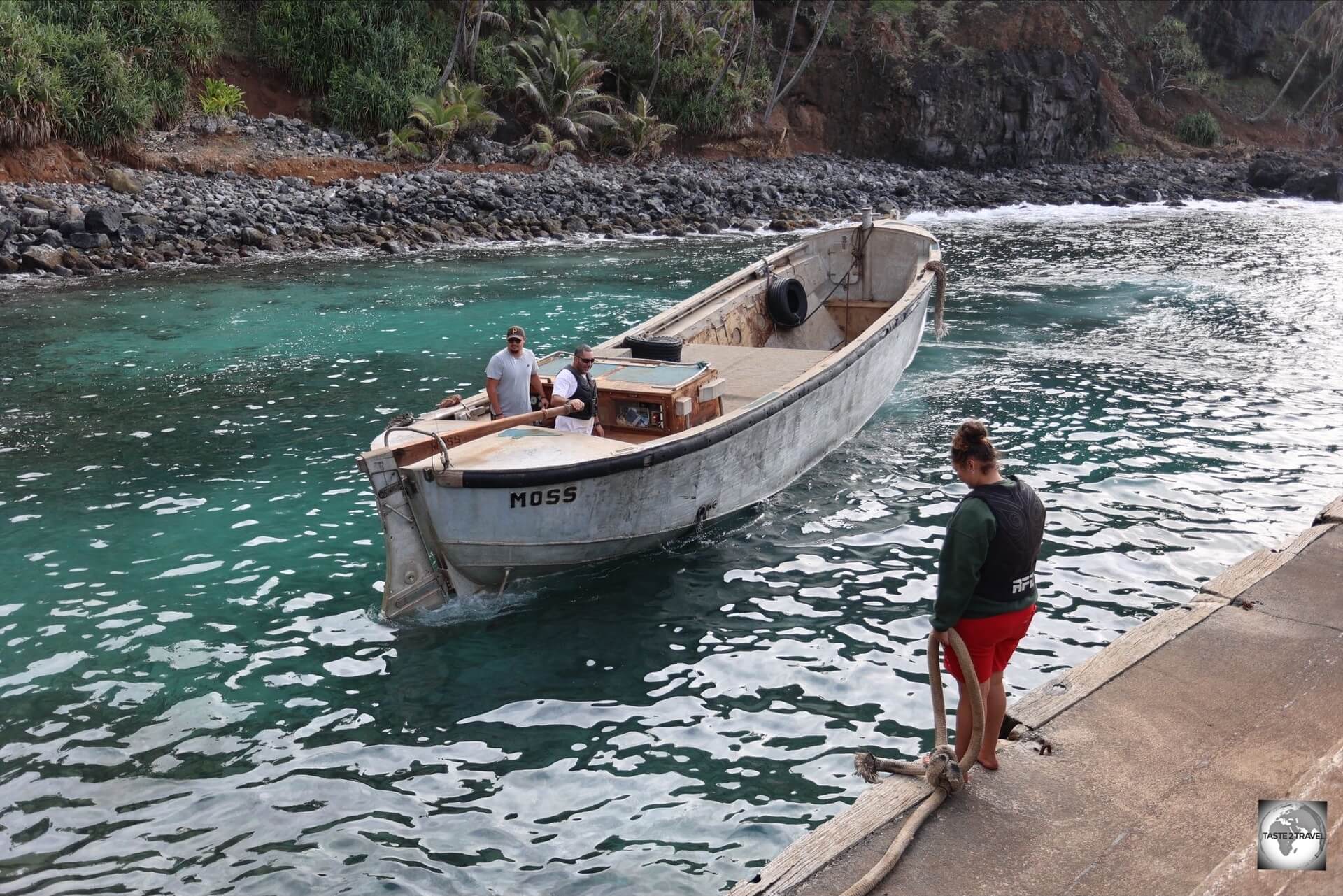
The freshly launched “Moss’ longboat in Bounty Bay.
Once in the water, the Moss ties up at the wharf where all passengers and their luggage is loaded.
The Moss then heads out to sea to meet the MV Silver Supporter which is always moored offshore.
It is worth noting that the “Moss” is the only functioning longboat on Pitcairn Island at this time – a potential single point of failure for the island!
Video:
Departing Pitcairn Island on the “Moss” longboat, on our way to board the MV Silver Supporter for the journey back to Mangareva, French Polynesia.
Once all passengers are aboard, the MV Silver Supporter commences its slow crawl back to Mangareva, arriving at around midnight on Monday night.
After breakfast on Tuesday morning, all passengers disembark, arriving at Mangareva port at 8:30 am.
First stop in Mangareva is the local Gendarmerie to get an entry stamp into French Polynesia.
From there, the municipal ferry to the airport (costs CFP 1,000) usually departs from the dock at around 9am.
The flight back to Papeete departs from Mangareva at 12 noon, arriving at 14:50.
Cruise Ships

When I arrived at Pitcairn Island, the majestic Bark Europa was visiting the island.
Several cruise ships call at Pitcairn Island each year.
All cruise ship arrivals are listed on the Cruise Ship Schedule page on the Pitcairn Island Tourist Office website.
Cruise ships typically spend just a few hours on the island with a landing being dependent on the sea conditions and at the discretion of the ship’s captain.
If a landing isn’t possible, the Pitcairn islanders will instead set up an arts and crafts pop-up store on board the ship where purchases can be made.
Ship passengers can also pay to have their passports stamped by Pitcairn Immigration.
Getting Around

Pitcairn Island road signs.
There is one 6.4 km (4 mi) concrete road leading up from Bounty Bay through Adamstown.

A typical country lane on Pitcairn Island.
There are many hiking trails and gravel tracks which provide access to most corners of the island.

There are many towering banyan trees on Pitcairn Island.
Whenever walking or hiking, caution must be front of mind since there are no medical facilities (except for a small clinic) anywhere near Pitcairn Island.

While there are no taxis on Pitcairn, Steve Christian has converted his quad bike into a deluxe ride, complete with a taxi sign.
In the event of a medical emergency, people need to be evacuated to French Polynesia on the slow supply ship then flown to the nearest hospital which is in Papeete – a journey of many days and many thousands of miles.

Exploring Pitcairn Island with my host Kerry Young on his quad bike.
The main modes of transport on Pitcairn Islands are four-wheel drive quad bikes and foot.
That’s the end of my Pitcairn Islands Travel Guide.
If you wish to provide feedback or leave a comment, you can do so using the form below.
Safe Travels!
Darren
Further Reading
Following is a list of other travel guides from the Pacific Ocean region:
- American Samoa
- Central Pacific Island Hopping
- Chuuk
- French Polynesia
- Galapagos Islands
- Guam
- Kiribati
- Kosrae
- Marshall Islands
- Nauru
- New Caledonia
- Niue
- Palau
- Papua New Guinea
- Pohnpei
- Samoa
- Solomon Islands
- Tonga
- Tuvalu
- Vanuatu
Author: Darren McLean
Darren McLean is an Australian, full-time, digital nomad who has spent 37 years on a slow meander around the globe, visiting all seven continents, 192/ 193 UN countries and 245/ 251 UN+ countries and territories.
He founded taste2travel to pique one’s curiosity and inspire wanderlust.





Dear Darren,
thank you for you interesting travel guide to Pitcairn!
In two days, on thursday, my adventure to pitcairn will begin.
Can’t wait to reach it!
Best wishes
Andy from Germany
Hi Andreas,
Wow! That is exciting news.
I hope you have a wonderful time on Pitcairn. It is a very special destination.
Safe travels,
Darren